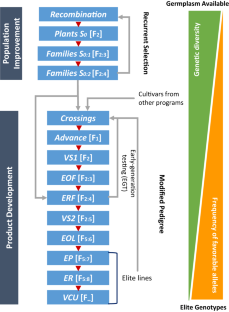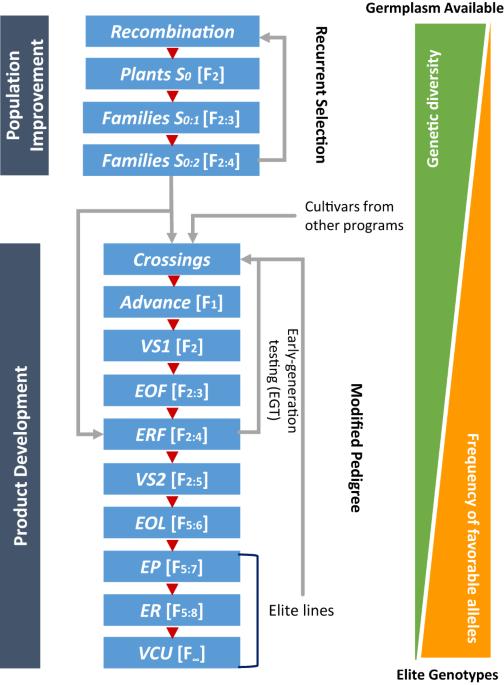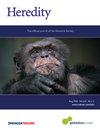Population improvement via recurrent selection drives genetic gain in upland rice breeding
IF 3.1
2区 生物学
Q2 ECOLOGY
引用次数: 0
Abstract
One of the main challenges of breeding programs is to identify superior genotypes from a large number of candidates. By gradually increasing the frequency of favorable alleles in the breeding population, recurrent selection improves the population mean for target traits, increasing the chance to identify promising genotypes. In rice, population improvement through recurrent selection has been used very little to date, except in Latin America. At Embrapa (Brazilian Agricultural Research Corporation), the upland rice breeding program is conducted in two phases: population improvement followed by product development. In this study, the CNA6 population, evaluated over five cycles (3 to 7) of selection, including 20 field trials, was used to assess the realized genetic gain. A high rate of genetic gain was observed for grain yield, at 215 kg.ha−1 per cycle or 67.8 kg.ha−1 per year (3.08%). The CNA6 population outperformed the controls only for the last cycle, with a yield difference of 1128 kg.ha−1. An analysis of the product development pipeline, based on 29 advanced yield trials with lines derived from cycles 3 to 6, showed that lines derived from the CNA6 population had high grain yield, but did not outperform the controls. These results demonstrate that the application of recurrent selection to a breeding population with sufficient genetic variability can result in significant genetic gains for quantitative traits, such as grain yield. The integration of this strategy into a two-phase breeding program also makes it possible to increase quantitative traits while selecting for other traits of interest.


通过循环选择进行种群改良,推动高原水稻育种的遗传增益
育种计划面临的主要挑战之一是从大量候选品种中发掘优良基因型。通过逐步提高育种群体中有利等位基因的频率,循环选择可提高目标性状的群体平均值,从而增加发现有潜力基因型的机会。在水稻育种中,除拉丁美洲外,通过循环选择进行群体改良的方法迄今还很少使用。巴西农业研究公司(Embrapa)的高原水稻育种计划分为两个阶段:群体改良和产品开发。在这项研究中,CNA6 群体经过五个选育周期(3 至 7)的评估,包括 20 次田间试验,被用来评估实现的遗传增益。谷物产量的遗传增益率很高,每个周期为 215 千克/公顷-1,即每年 67.8 千克/公顷-1(3.08%)。只有在最后一个周期,CNA6 群体的表现优于对照组,产量相差 1128 千克/公顷。根据对第 3 至第 6 个周期衍生品系的 29 项先进产量试验进行的产品开发流水线分析表明,从 CNA6 群体衍生的品系谷物产量较高,但并未超过对照品系。这些结果表明,在具有足够遗传变异性的育种群体中应用循环选择,可以显著提高谷物产量等数量性状的遗传收益。将这一策略整合到两阶段育种计划中,还能在选择其他相关性状的同时增加数量性状。
本文章由计算机程序翻译,如有差异,请以英文原文为准。
求助全文
约1分钟内获得全文
求助全文
来源期刊

Heredity
生物-进化生物学
CiteScore
7.50
自引率
2.60%
发文量
84
审稿时长
4-8 weeks
期刊介绍:
Heredity is the official journal of the Genetics Society. It covers a broad range of topics within the field of genetics and therefore papers must address conceptual or applied issues of interest to the journal''s wide readership
 求助内容:
求助内容: 应助结果提醒方式:
应助结果提醒方式:


